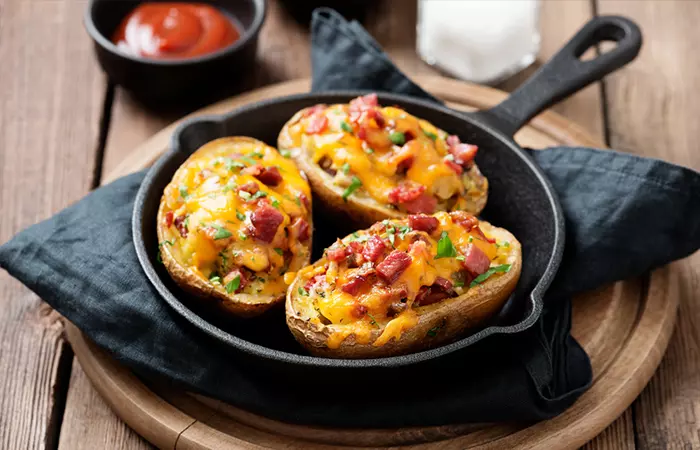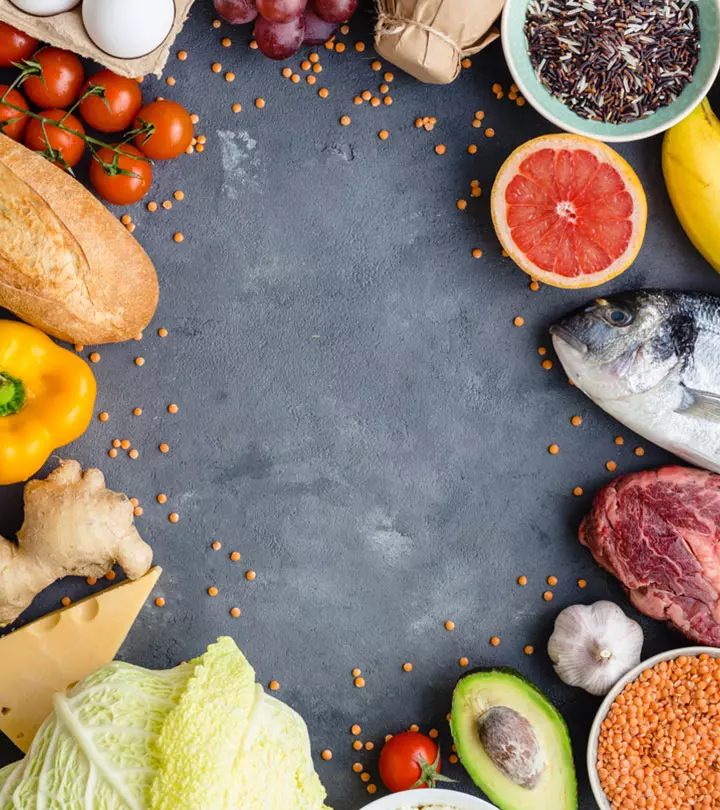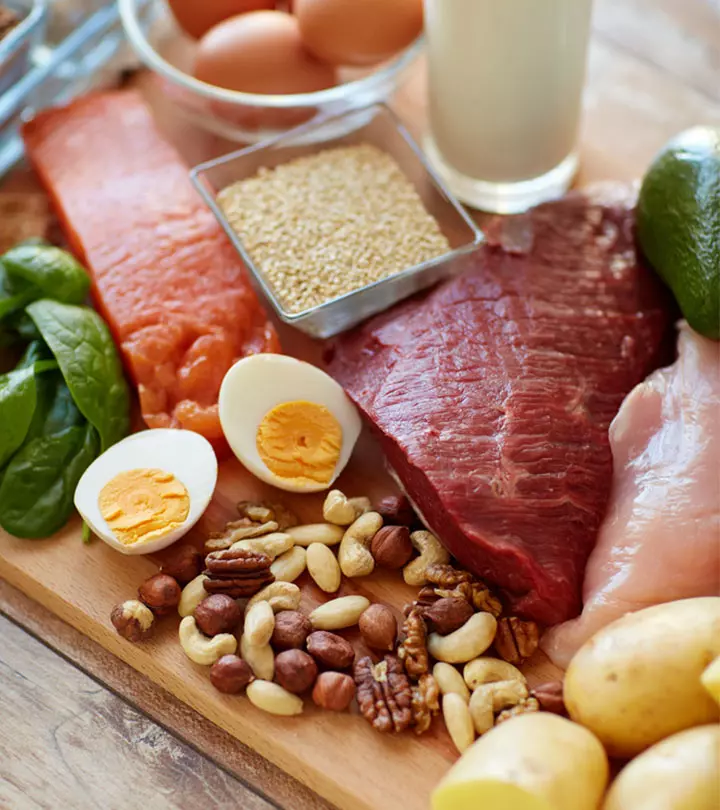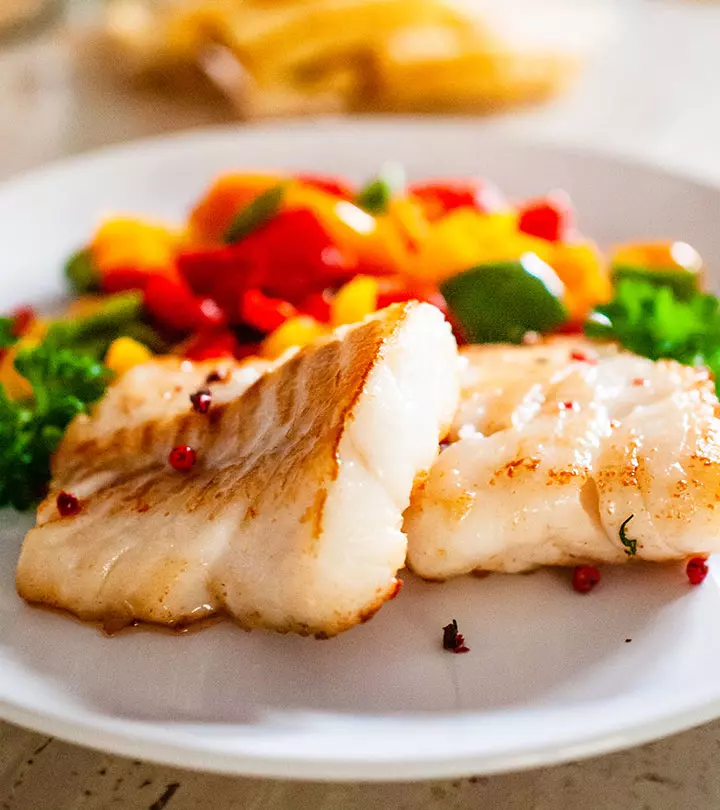Vertical Diet: How It Works, Benefits, And Foods List
Elevate your fitness journey with this high-calorie and nutrient-dense diet.

Image: Shutterstock
The latest trending nutrition strategy making waves in the health and fitness community is the vertical diet. This unique approach to eating with more focus on white rice and red meat has gained the attention of athletes, bodybuilders, and health enthusiasts alike, promising not just weight management but also improved performance, enhanced energy levels, and better overall health.

But what exactly is the vertical diet, and how does it differ from other popular diet plans? In this article, take a deep dive into the principles, benefits, meal plans, and potential drawbacks of this diet. Keep reading to explore how the vertical diet can potentially reshape your approach to food and nutrition.
 At A Glance: Vertical Diet
At A Glance: Vertical Diet- Principle: Consuming nutrient-dense foods that focus on micronutrientsi Essential nutrients that your body requires in relatively small amounts to function properly and maintain good health. such as vitamins, minerals, and antioxidants.
- Purpose: To manage weight and build muscle.
- Who It Is For: Athletes who need to maximize their performance, individuals who want to gain weight or muscle mass, and those who have gastrointestinal problems.
- Duration: Short-term
- Who Should Avoid: Individuals with (a history of) eating disorders or obesity and those who do not exercise regularly.
- Cons: May cause constipation, diarrhea, and indigestion during the initial stages.
In This Article
What Is The Vertical Diet? How Does It Work?

The vertical diet involves consuming foods that are easy for your body to digest and speed up the nutrition absorption process to deliver the nutrients quickly. This diet was created by Stan Efferding, a professional bodybuilder, and it is all about eating nutrient-dense foods that focus mainly on micronutrients such as vitamins, minerals, and antioxidants.
Mary Sabat, Registered Dietitian Nutritionist, says, “The vertical diet is for athletes who engage in intense physical training. It focuses on helping them get enough good nutrition in an easily digestible form. It cuts out all processed foods and focuses on real, nutrient-dense foods. It is not a diet for people who are sedentary, diabetic, etc. but rather for athletes doing heavy training.”
The diet gets its name because of how it is structured – like an upside-down T. At the bottom of the inverted T, there are vegetables, dairy, fruits, and starches that provide necessary micronutrients like vitamins and minerals. At the top, there are two foods – white rice and red meat – that provide the macronutrientsi Essential nutrients that make up the bulk of your diet and provide your body with energy in the form of calories. like protein, carbohydrates, and fats. However, the amount of food you need to consume depends on your fitness goals and strength. The diet mainly depends on how many calories you add or subtract from your diet based on your Basal Metabolic Ratei The rate at which your body expends energy (measured in calories) while at rest, in a fasting state. (BMR). You must add more calories based on your BMR to gain weight and subtract calories to lose weight.
Through this diet, you can gain or lose weight, improve your workout performance, and achieve better nutrient absorption. Read on to learn more about the benefits of this diet.
Key Takeaways
- The vertical diet involves eating nutrient-dense foods that focus mainly on micronutrients such as vitamins, minerals, and antioxidants.
- It may help support muscle gain, manage your weight, and relieve digestive symptoms.
- The amount of calories you need to add or subtract depends on your training regimen..
- The important foods used to increase calories in this diet are white rice and red meat.
Benefits Of The Vertical Diet
1. May Aid Weight Loss

The vertical diet emphasizes the consumption of nutrient-dense and non-processed foods. Anecdotal evidence suggests that following such a diet may aid digestion, maximize exercise performance, and improve nutrient absorption. With an effective workout, better nutrition absorption, and proper calorie intake, you may experience weight loss.
2. May Boost Muscle Gain
Following the calorie-surplus of this diet involves increased carbohydrate intake. Diets rich in carbohydrates and calories may help improve muscle mass. At least a 15% increase in energy intake is a must for muscle building (1). This diet plan can form a good base for a bulking diet for professional athletes and bodybuilders who aim to increase muscle mass without compromising digestion or nutrient intake. Additionally, eating carbs before working out may provide energy and enhance athletic performance.
Additionally, eating carbs before working out may provide you with energy and enhance athletic performance.
3. May Help Ease Digestive Symptoms

On this diet, you are recommended to consume low-FODMAPi A group of short-chain carbohydrates and sugar alcohols that are poorly absorbed in the small intestine. foods. This may help reduce digestive symptoms related to irritable bowel syndrome (IBS), such as bloating, pain, and flatulence (2). This may help bodybuilders and athletes deal with gastric issues that may otherwise impair muscle and weight gain by limiting food intake.
Now that you know the benefits of following this diet, let us find out how to go follow this diet regimen.
How To Start The Vertical Diet
Calculate your BMR to check the number of calories you should consume daily and the total energy your body burns while at rest. The amount of calories you need to add or subtract is dependent on your training regimen. Determine your appropriate calorie intake by considering your body weight and calculating the grams of protein, fat, and carbohydrates you should consume. As your body adjusts to the diet and starts to feel hungry between meals, you can increase the calories. This may lead to greater muscle gains, quicker recovery, and more intense or frequent training sessions.
The best way to increase calories in your vertical diet is to add a portion of white rice or red meat to your meal plan. A 100 g of white rice contains 130 kcal and 28.6 g of carbohydrates (3). As a primary source of carbs, it may help athletes and fitness enthusiasts with very high calorie needs.
Red meat is preferred because of its nutrient density and concentration of protein, omega-3 fatty acids, vitamin B12, niacin, zinc, and iron that may aid muscle growth (4), (5).
Nonetheless, it may not be possible to fulfill all your micronutrient requirements solely through these two foods. The vertical diet allows a restricted quantity of nutrient-packed, readily digestible items. Scroll down to find out which foods you can include in this diet.
Foods To Eat On The Vertical Diet
- Grains: White rice, amaranth, burghul, buckwheat, corn, oats, millet, and quinoa
- Proteins: Salmon, beef tallow, hormone-free chicken, bison, grass-fed beef, and whole eggs
- Fruits: All fruits, especially oranges, cranberries, grapes, melons, grapefruits, and strawberries
- Vegetables: Low-FODMAP vegetables like peppers, spinach, carrots, celery, peppers, and cucumbers
- Legumes: Soaked legumes and oats (in small quantities)
- Oils And Fats: Extra-virgin olive oil, butter, avocado oil, coconut oil, and nuts
- Seeds: Chia seeds, flaxseeds, pumpkin seeds, and sunflower seeds
- Healthy fats: Full-fat yogurt, whole milk, and cheese
- Sodium: Bone broth, chicken stock, and iodized table salt
Consider adding supplements like creatine, whey protein, and omega-3 fatty acids to your diet and regular meals to help promote muscle growth and recovery. These supplements help maximize your performance and fill nutritional gaps. Be sure to speak with a healthcare provider to make sure they meet your dietary requirements.
High-quality foods, such as grass-fed meats, free-range eggs, and organic fruits and vegetables, are highly encouraged in this diet. Now, let us find out what you cannot have on this diet.
Foods To Avoid On The Vertical Diet
Highly processed and difficult-to-digest foods are discouraged in this diet. The foods you should avoid include:
- Grains: Brown rice, breakfast cereals, unsoaked oats, pasta, bread, and wheat flour
- Legumes: Unsoaked lentils, soy, peanuts, beans, and peas
- Oils: Highly processed vegetable oils like corn oil, soybean oil, canola oil, and safflower oil
- Onions And Garlic: All forms of onion, garlic, and shallots
- Vegetables: High-FODMAP vegetables like broccoli, kale, asparagus, cauliflower, Brussels sprouts, and cabbage
- Added Sugar: Candy, soda, pastries, sports drinks, and baked goods
- Coffee: Regular coffee and decaf coffee
- Other Beverages: Alkalized water and sugar alcohols
- Meat: Sausage, salami, and bacon
- Poultry: Non-organic chicken
- Dairy Products: Flavored yogurt and heavy cream
While preparing a vertical diet meal plan, you need to carefully analyze all the foods you include and avoid for effective results. Scroll down to the next section for a sample meal plan to get started.
Vertical Diet Meal Plan
Here is a sample menu for the Vertical Diet:
- Breakfast: 2 whole eggs scrambled with cheese, red meat, spinach, and a side of berries. You may also have a cup of unflavored Greek yogurt with strawberries, coffee, and full-fat milk.
- Lunch: 1 cup of white rice with ground bison, bone broth, spinach, peanuts, and sweet potato. You can also have 4 ounces of orange juice.
- Dinner: Hormone-free chicken (85-115 g) with an egg, roasted carrots, zucchini, and a side of grapes. You may also consume 4 ounces of cranberry juice.
- Snack: 1 cup of unflavored Greek yogurt with berries, whole milk, or baby carrots.
Make sure you balance macronutrients and micronutrients by customizing your meal plan and modifying portion sizes and food selections according to your individual fitness goals. This method supports specific nutritional goals, such as weight loss or muscle building, while allowing for flexibility.
 Quick Tip
Quick TipThe number of meals you include in the diet may vary based on your training regimen and calorie needs. Therefore, you need to plan the foods and recipes accordingly. Keep reading to learn a few recipes you can try out while following this diet.
Vertical Diet Recipes
1. Scrambled Eggs With Cheese

Ingredients
- 2 large eggs
- 1/2 teaspoon of salt
- 1/2 teaspoon of pepper
- 1 teaspoon of olive oil
- 3 cups of spinach
- 3 cups of bell peppers
- 3 cups of shredded carrots
- 1 tablespoon of mozzarella cheese
How To Prepare
- Whisk the eggs in a bowl.
- Season with salt and black pepper and set aside.
- Heat up the olive oil in a non-stick skillet over medium heat.
- Add in the spinach, bell peppers, and shredded carrots.
- Cook for around 2 minutes.
- Add in the eggs and stir for a minute or two.
- When the eggs are set, turn the heat off.
- Fold the shredded mozzarella cheese into the scrambled eggs.
2. Beef Monster Mash

Ingredients
- ½ tablespoon of olive oil
- 5½ ounces of sweet potatoes
- 1 red bell pepper
- 7 ounces of zucchini
- 8 ounces of ground beef
- 1 cup of beef bone broth
- ½ tablespoon of salt
- ¼ tablespoon of black pepper
- ½ teaspoon of oregano
- ½ teaspoon of paprika
- ½ teaspoon of cayenne pepper
- Chili powder to taste
How To Prepare
- Place a pan on the stove and turn the heat to medium.
- Cut the sweet potatoes, red bell peppers, and zucchini into ¼-inch pieces.
- Pour the olive oil into the pan and let it heat up.
- Add the vegetables to the pan.
- Once the vegetables turn brown, move them to one half of the pan.
- Add the ground beef to the other half of the pan.
- Mash the ground beef and let it cook.
- After 4-5 minutes, mix the beef and vegetables together.
- Add the salt, pepper, paprika, oregano, and cayenne pepper and stir well.
- Add the beef bone broth and let it cook for 10 minutes.
 Pro Tip
Pro Tip3. Loaded Sweet Potatoes

Ingredients
- 2 medium to large sweet potatoes
- ½ teaspoon of salt
- ½ teaspoon of black pepper
- 250 g fresh corn niblets
- 1 tablespoon of extra virgin olive oil
- 25 g fresh coriander
- 1 large ripe avocado
- Lemon juice as per your taste
- ¼ teaspoon of chili powder
- ¼ teaspoon of ground cumin
How To Prepare
- Preheat your oven to 400°F.
- Line a sheet pan with parchment paper.
- Poke holes into each sweet potato with a fork.
- Place them on the sheet pan and roast them for 45-60 minutes.
- Let them cool for 10 minutes. Set aside.
- Blend the coriander, lime juice, avocado, salt, black pepper, cumin, and chili powder in a blender. Set aside.
- Heat oil in a frying pan over medium heat.
- Add the corn to the pan and cook for 3-5 minutes. Set aside.
- Slice the sweet potatoes lengthwise and score the inner flesh with a fork.
- Top the sweet potatoes with the avocado and coriander mixture, followed by the cooked corn niblets.
- Sprinkle some salt and pepper on top.
- Season with chili powder and cumin to taste.
Incorporating these recipes into your diet plan may help increase your calorie intake. Though the vertical diet can help improve your fitness level, there may also be a few downsides associated with it. Read on to learn about them.
Side Effects Of The Vertical Diet
- Reduced Fiber Intake
The recommended dietary fiber intake for children and adults is 14 g/1000 kcal. Adequate fiber intake is not only important for digestion and regular bowel movements, but it may also lower the risk of chronic diseases, including lower risk of developing Coronary heart diseasei A medical condition that occurs when the blood vessels that supply blood to the muscles of the heart become narrowed or blocked. , stroke, Hypertensioni Also known as high blood pressure, a medical condition characterized by elevated or abnormally high blood pressure in the arteries. , diabetes, obesity, and certain gastrointestinal diseases (6). However, the vertical diet does not contain enough fiber.
- Reduced Prebiotic Intake
This diet restricts many important sources of Prebioticsi A type of non-digestible dietary fiber that serves as food for beneficial bacteria in the digestive system, particularly in the colon. , such as garlic, onions, and barley that help improve gut health and prevent obesity (7). The lack of prebiotics and fiber in the diet may cause gut problems like constipation, indigestion, and diarrhea.
- Increased Risk Of Nutrient Deficiencies
It also lacks diversity of foods and may lead to nutrient deficiencies if not planned properly. Therefore, it is important to consult a dietitian to plan this diet accordingly.
- Not Suitable For Vegetarians And Vegans
The diet is not fit for vegetarians and vegans to follow as it focuses on red meat intake and limits vegetable, grain, and legume intake.
In addition, limiting some food groups may lead to anxiety about food choices or feelings of deprivation, both of which can have an adverse effect on mental health.
The vertical diet has captured the attention of those seeking not just to improve weight management but spark an overall boost in their athletic performance and muscle gain. Its focus on easily digestible, nutrient-dense foods is designed to optimize nutrient absorption and enhance athletic performance. The main foods used in the diet to increase calories include white rice and red meat. Along with other easily-digestible and low-FODMAP food that provide sufficient energy required to achieve your fitness goals, However, it’s essential to approach this dietary approach with awareness. While it can yield significant benefits, it may also pose challenges, particularly in terms of fiber and prebiotic intake. Therefore, it is best to consult a nutritionist or dietician to tailor it to your individual needs and goals.
Infographic: Foods To Eat And Avoid On The Vertical Diet
The vertical diet is a unique approach to boost your muscle gain. It has especially gained popularity among bodybuilding enthusiasts for this reason. However, you need to be careful while planning your meals while following this diet. Check out the infographic below to learn more about the foods you need to include and avoid to make the most of this diet.
Some thing wrong with infographic shortcode. please verify shortcode syntaxFrequently Asked Questions
How many meals should you have in a day on the vertical diet?
The number of meals you have in a day may vary based on your training regimen and calorie needs. However, the supporters of the diet recommend having four meals a day, including breakfast, lunch, dinner, and snack.
Can you drink tea on the vertical diet?
Mary says, “It recommends restricting certain beverages with caffeine but does not exclude tea for everyone.” Nevertheless, consuming tea may cause gastric troubles (8).
Illustration: Vertical Diet: How It Works, Benefits, And Foods List

Image: Stable Diffusion/StyleCraze Design Team
Are you looking for a diet to improve your muscle gain? Watch this video to discover how the vertical diet can help you build muscles with a 2-week diet plan.
References
Articles on StyleCraze are backed by verified information from peer-reviewed and academic research papers, reputed organizations, research institutions, and medical associations to ensure accuracy and relevance. Read our editorial policy to learn more.
- Macronutrient considerations for the sport of bodybuilding
https://pubmed.ncbi.nlm.nih.gov/15107010/ - A diet low in FODMAPs reduces symptoms of irritable bowel syndrome
https://pubmed.ncbi.nlm.nih.gov/24076059/ - Rice, white, medium-grain, cooked, unenriched
https://fdc.nal.usda.gov/fdc-app.html#/food-details/168930/nutrients - Lean meat and heart health
https://pubmed.ncbi.nlm.nih.gov/15927927/ - Protein-enriched diet, with the use of lean red meat, combined with progressive resistance training enhances lean tissue mass and muscle strength and reduces circulating IL-6 concentrations in elderly women: a cluster randomized controlled trial
https://pubmed.ncbi.nlm.nih.gov/24477043/ - Health benefits of dietary fiber
https://pubmed.ncbi.nlm.nih.gov/19335713/ - Fiber and prebiotics: Mechanisms and health benefits
https://www.mdpi.com/2072-6643/5/4/1417 - Effect of tea on gastric acid secretion
https://pubmed.ncbi.nlm.nih.gov/6546540/
Read full bio of Tracy Tredoux
Read full bio of Moksha Gandhi
Read full bio of Arshiya Syeda
Read full bio of Himanshi Mahajan



























Community Experiences
Join the conversation and become a part of our empowering community! Share your stories, experiences, and insights to connect with other beauty, lifestyle, and health enthusiasts.